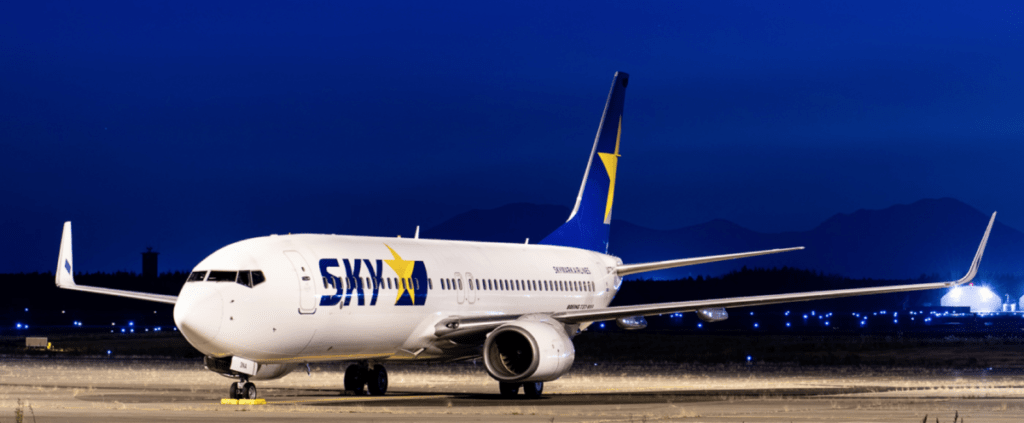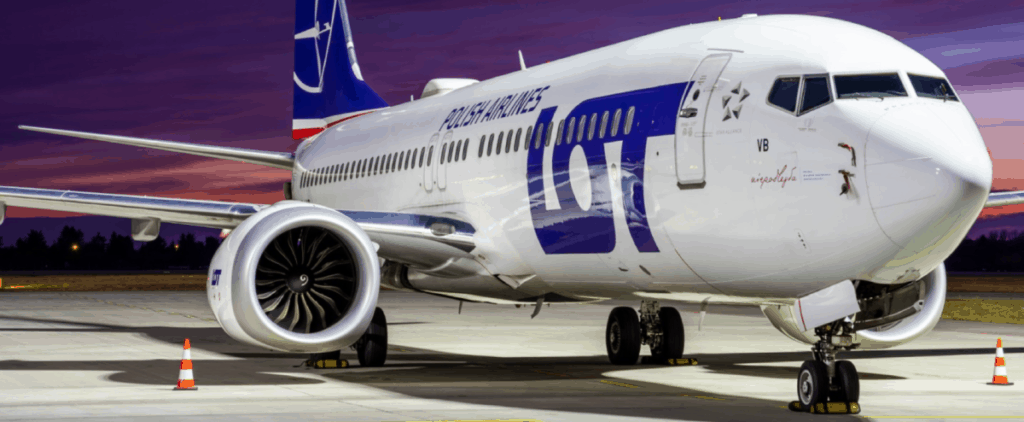
Modern transport aircraft designers have settled on two primary layouts; engines slung beneath the wing and for smaller aircraft, engines mounted on the aft fuselage. The most ubiquitous of these wing mounted designs is 737, but it features a distinctive flat bottomed, “smashed” engine inlet. Why is the 737’s engine inlet oddly shaped, when similar aircraft have round engine inlets?
The 737’s flat engine nacelle is designed to provide more ground clearance despite its short landing gear. As modern and larger turbofan engines were adopted, to maintain proper ground clearance it was less costly and complicated to modify the shape of the engine versus the gear or airframe itself.
In order to better understand why the engines appear “flat”, we need to first look at the history and design evolution of the 737 itself.
Design History of the 737
The 737 was originally flown in 1965 with the intent that it would serve similar routes and airfields as the 727, this original 737 was produced in “-100” and “-200” variants with the primary difference being fuselage length.
Part of the design requirements included the use of short, simple and (relatively) light weight landing gear, which accommodated the common Pratt and Whitney JT8D low bypass turbofan engine.
High bypass turbofan engines had not yet become common, particularly on smaller aircraft, making the choice of the JT8D (which flew in the Grumman A-6 intruder and Saab 37 Viggen fighter jets) engine a natural choice for the aircraft.
By 1980, changes in the airline market and competitive pressure from the DC-9 drove Boeing to revise the aircraft, with significant focus on improved fuel economy.
The short landing gear and underwing engine location resulted a difficult engine selection process. Ultimately Boeing selected the CFM International CFM56 engine, modified to meet the installation requirements.
CFM International repositioned engine accessories to the sides of the engine, and modified the intake shape and diameter. Boeing positioned the engines ahead of the wing to achieve sufficient ground clearance and maintain an optimum ratio between engine inlet diameter and the height of the inlet above the ground.
The flat bottom of the nacelle helped to maximize this distance and avoided a major redesign of the wing and landing gear system.
Why Did Boeing Not Redesign the Main Landing Gear to Place the Engine Under the Wing?
The 737’s engine installation is distinctive in the commercial aviation market and arguably less effective than simply lengthening the landing gear to allow placement of the engines below the wing “where they belong.”
Redesign of the landing gear to permit the larger CFM56 engines to fit under the wing would have necessitated redesign of not just the gear but the wing structure and fuselage fairing.
This would result in renewed structural certification testing and limited the ability of the designers to capitalize on the existing 727 architecture from which much of the 737’s components and structures were derived.
Why Were the Landing Gear So Short?
At the time of the 737’s introduction, it was intended to service similar airfields as the 727, meaning relatively short runways and perhaps limited terminal infrastructure. At the time of introduction commercial aviation terminals at small airports often only had airstairs for passenger boarding, instead of the jet-bridges that are now ubiquitous.
Shorter, easier to climb airstairs encouraged the design of shorter aircraft that simplified the loading and unloading of passengers.
Additionally, landing gear are heavy, complicated pieces of hydraulic machinery with their own challenges, design and certification requirements. Using existing landing gear systems is a far more cost effective design solution, particularly for aircraft intended to be low cost.
Would It Be Easier to Change the Wing Design to Improve Efficiency?
Boeing has used aerodynamic “treatments” to the 737 wing to improve its efficiency, but these changes typically produce improvements in the 1% to 2% range. Longer wings with a higher aspect ratio would conceivably add additional improvements the 737’s aerodynamic efficiency.
Ultimately aerodynamic drag is a relatively small component of an aircraft’s fuel efficiency.
The 737 was designed to service a fixed size parking space at commercial terminals, limiting the ability of designers to expand the wingspan of the aircraft. And as the aircraft gained mass popularity in the 1980s and 1990s, terminal design requirements became to some extent predicated on the 737’s overall size.
In a sense the success of the design team in 1980 to position the engines ahead of the wing made the 737 a victim of its own brilliance, limiting the ability of designers to modify the aircraft to place the wing in a “normal” position.
Is There an Engine Difference Between the “Classic” 737 and the 737 MAX?
The 737 MAX uses a larger, more efficient CFM International LEAP-1B engine, that promises 10% or more higher fuel efficiency compared the CFM56 series of engines. As a result of the larger engine diameter, the engine is mounted even farther ahead of the wing to avoid structural changes to the wings and main landing gear.
Visual comparison of the “Classic” inlet and the “MAX” inlet shows the MAX to have a similar flat bottomed nacelle, but a circular inlet.


The new engine improves the bypass ratio from the 5.1:1 of the CFM56 to 9:1. The fan increased in diameter from 61 inches to 69 inches which lead to a slightly taller nose gear.
The downside of the new engine position was a change in pitch stability that necessitated the incorporation of the now famous MCAS system. The other primary visually distinctive modification of the engines is the addition of scalloping to the trailing edge of the engine bypass section, a design improvement inherited from the 787. This scalloping reduces engine and aerodynamic noise.
What Factors Drive Jet Engine Efficiency?
A wide range of factors drive jet engine efficiency with the primary factors being: bypass ratio, compression ratio, combustion temperature limits and power extraction from aircraft systems.
Of these factors, bypass ratio is the largest contributor to overall efficiency and is the relationship between the air that flows around the combustion section and the air that is burned to produce thrust. In basic terms the more air that can be turned into thrust using the least amount of fuel will maximize the efficiency of the engine.
Modern high bypass turbofan engines like the CFM56 and LEAP-1B produce the vast majority of their thrust from the fan section of the engine rather than the combustion and turbine sections, relatively small turbine sections to drive the large fans that are visible at the front of the engine, minimizing the fuel required to propel the aircraft.
Additional efficiency is gained from the higher compression ratios of the more modern LEAP-1B. The compression ratio describes the amount of work done by the engine core’s compression section prior to combustion of the fuel. The higher this ratio, the more energy can be extracted to power the turbine and aircraft systems.
It also relates to the combustion temperatures and overall fuel burn. Higher compression allows the use of less fuel burned at a leaner mixture ratio, and thus at higher temperatures.
For combustion cycles, higher combustion temperatures allow more energy to be extracted from the engine. The LEAP-1B makes significant improvements on all of these factors, allowing for the significant fuel efficiency improvements.
Conclusion
The 737’s evolution from the original JT8D engine to the CFM56 engine was driven by competitive pressure from the DC9 and the need for more efficient airliners.
Because major structural modifications and significant aerodynamic changes were either too costly or too complicated to achieve, the distinctive flat bottomed oblong engine inlet and cowling were adopted.
The brilliance of positioning the engines ahead of the wing and distorting the inlets allowed the 737 to become the massively successful aircraft that has become so recognizable around the world.



